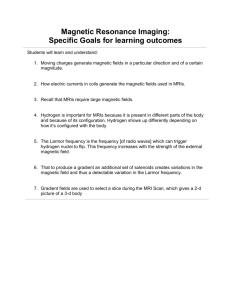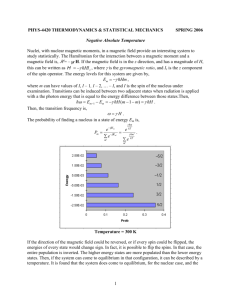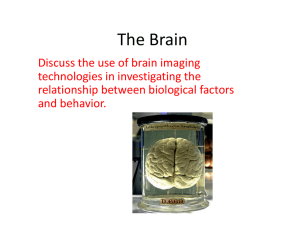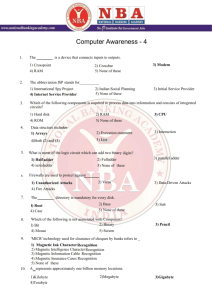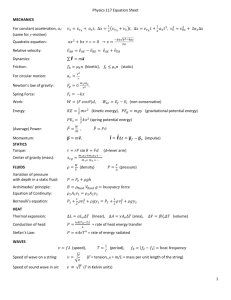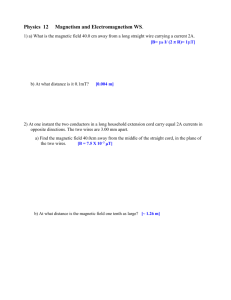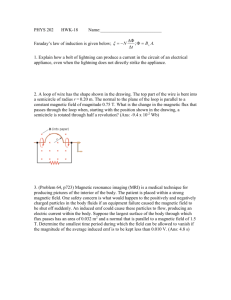Intro_to_MRI
advertisement
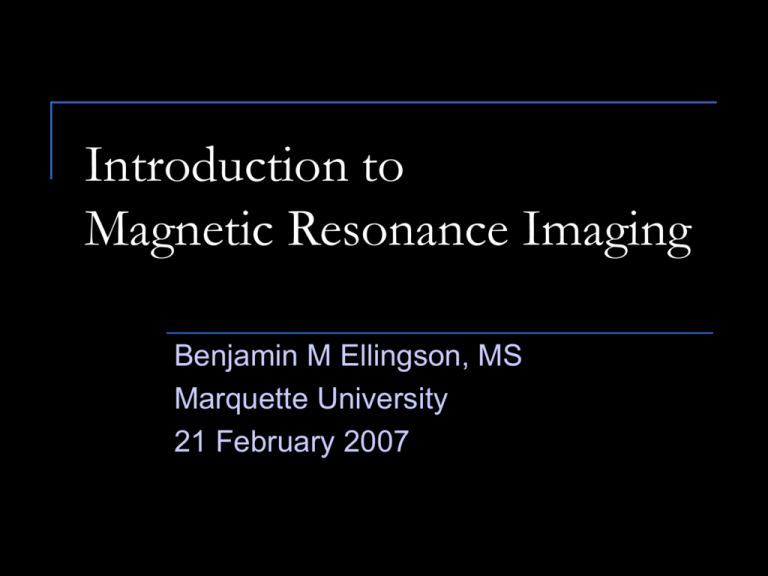
Introduction to Magnetic Resonance Imaging Benjamin M Ellingson, MS Marquette University 21 February 2007 Quantum Theory of Magnetic Resonance Quantum Theory of Magnetic Resonance Magnetic Moment, M0 Angular Momentum Low Energy = Parallel High Energy = Antiparallel Quantum Theory of Magnetic Resonance Quantum Theory of Magnetic Resonance So, B0 (static magnetic field) causes some particles to align antiparallel, but most align parallel Classical View: Vector sum of all magnetization is parallel to B0 M0 B0 Classical View is easier to conceptualize…however some quantum restraints… Theory of Magnetic Resonance Because of the Uncertainty Principle, spins cannot completely align with B0 because the momentum of the particle cannot be defined completely, instead they precess or wobble around B0 at the Larmor Frequency. Magnetic Field Larmor Frequency Gyromagnetic Ratio (specific to atom; 1H 42.6 MHz/T Theory of Magnetic Resonance Laboratory Frame of Reference: See m rotating about B0 with net magnetization in z-direction, Mz. The time average value of Mxy is 0. Mz m Mxy Rotating Frame of Reference: Observer is rotating at the precession frequency, such that m is not moving. All we see all the components of m. In rotating frame of reference we will call this M0. So, placing many 1H atoms in a static magnetic field M0 = Mz. Perturb Magnetic Equilibrium By applying a horizontal oscillating field at Larmor frequency (B1) produces a torque on the magnetization vector, M0. Since |B1| << |B0| the net field is still in z-dir Causes M0 to “tip” into xy-plane. RF Excitation Laboratory Frame of Reference: Rotating Frame of Reference: RF Excitation: Effect of Frequency Static B1: B1(t) = B1 cos (0.5wt) B1(t) = B1 cos (1.5wt) B1(t) = B1 cos (wt) B1(t) = B1 cos (2wt) Relaxation After excitation, if B1 field is turned off the spins undergo relaxation in both transverse and longitudinal directions at different rates. Transverse Relaxation = T2-relaxation = Spin-Spin Relaxation Corresponds to dephasing of neighboring spins Causes decrease in Mxy Longitudinal Relaxation = T1-relaxation = Lattice Relaxation Causes increase in Mz after excitation MR Signal If we have a lot of 1H excited such that they are spinning in phase in the xy-plane (i.e. changing magnetic field) we can detect this with an antenna due to Faraday’s Law of Induction: Antenna Total Magnetization MR Signal: Free Induction Decay As T2 relaxation occurs (Mxy decreasing), sinusoidal signal at antenna decays with T2 envelope Free Induction Decay (FID) Localization via Magnetic Field Gradients In a static magnetic field, we have no way of knowing where MR signal is coming from (i.e. all 1H are precessing at same frequency): Localization via Magnetic Field Gradients To solve this problem we introduce a GRADIENT FIELD Gradient magnetic fields add to or subtract from the main magnetic field in a controlled and predictable pattern so the field is no longer homogeneous. Localization via Magnetic Field Gradients Localization via Magnetic Field Gradients FREQUENCY ENCODE Localization via Magnetic Field Gradients Frequency Encoding causes 1-D localization but what about other dimensions? Use field gradients to Phase Encode signal By pulsing a gradient in another direction we can speed up or slow down spins Localization via Magnetic Field Gradients Gradient TurnedMagnetic Off: On: Spins in Static Field: Same frequency but different phase! 2-D Spatial Frequency Domain: k-space The FID Echo We get maximum signal when all spins are in phase and no signal when spins are dephased. Just as we used a pulsed gradient to phase encode, we can use pulsed gradients to rephase after dephasing has occurred. The process of rephasing spins causes a symmetric FID with maximum at time when spins are completely rephased. Slice Selection The previous RF excitation was applied to all 1H-spins in the body because they were all at the Larmor Frequency (w0 = gB0). If we apply a gradient, Gss, while applying RF excitation at a very specific frequency we can excite an infinitely thin layer of spins. Practically, we want to excite a “slab” of spins so we have high signal, therefore we envelope the RF excitation in a sinc function. The MRI Pulse Sequence Ideal Gradient Recalled Echo (GRE) Slice Selection Phase Encode Frequency Encode K-space FID Echo FID MRI Pros & Cons Pros Non-ionizing radiation Limitless Contrast Possibilities (based on Pulse Sequence Design) Can image in any plane (vs. Axial only for CT) Exquisite Resolution & Soft Tissue Contrast Cons Relatively Slow (changing due to better hardware and sequence design such as EPI) No metal (although most implants are now MR compatible) Claustrophobia & Loud Clinical Applications Too Numerous to list them all Angiography Diffusion fMRI (BOLD & ASL) Cardiac Medical Imaging & Computing Making information accessible Reconstruction & Processing Algorithms CAD, 3D Visualization, Modality Registration Novel Pulse Sequence Image Reconstruction Real-time Image Reconstruction Code optimization for fast imaging sequences Archival & Storage DICOM, PACs, Image Compression Additional Info & References Additional Information Medical College of Wisconsin Biophysics http://image.nih.gov Johns Hopkins Biophysics Group http://www.mcw.edu NIH Image Processing Interest Group http://www.ellingsonbiomedical.com/MRI/Lectures/Intro_to_ MRI.htm http://biophysics.jhu.edu Stanford Magnetic Resonance Laboratory http://smrl.stanford.edu
